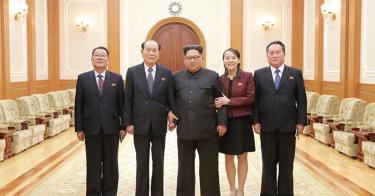North Korea has been a top foreign policy priority since President Donald Trump settled into the Oval Office. The president has repeatedly expressed his intention to "solve" the North Korean crisis, emphasizing that all policy options — including military actions — are on the table.
But there are no good military options for dealing with North Korea. U.S. military action will certainly not de-escalate tensions on the Korean peninsula. Indeed, it could drag our ally in the south into an involuntary game of Russian roulette, leaving Seoul’s civilian population of more than 25 million vulnerable to devastating artillery shelling — or worse — from the North.
And military options are not likely to achieve the primary U.S. objective: a denuclearized North Korea.
The merit and likelihood of the United States using military options against North Korea aside, what is perhaps equally alarming is the lack of conversation regarding the necessity of developing and implementing comprehensive contingency plans to deal with potential instability in North Korea.
North Korea could be destabilized by domestic events — such as a high-level coup or humanitarian crisis — as well as by the actions of foreign powers. While no one can predict with certainty if, when, and how a collapse will occur, that does not mean the United States cannot or should not prepare for them.
There are at least three known contingency plans — plans about which the public knows little. My own conversations with U.S. and South Korean officials, however, indicate that existing plans give relatively little attention to dealing with human rights and humanitarian concerns.
A conversation with a State Department representative revealed that one of the least developed components of the plans is how to address North Korea’s political prison camps.
According to a 2014 U.N. Commission of Inquiry report, these camps hold somewhere between 80,000 and 120,000 political prisoners. Several thousand more are housed in ordinary prison camps. Inmates in both camps endure forced labor, starvation and various other life-threatening conditions.
With the aid of satellite imagery and information from North Korean defectors, the Committee for Human Rights in North Korea has identified more than 30 ordinary and political prison camps run by the regime. There are probably many more.
Should North Korea suffer a collapse, rescuing prisoners from these camps would be a matter of life or death. According to former North Korean prison guard Ahn Myong Chol, guards at the camps are under orders to kill all prisoners in the event of an invasion. Ahn said that the camps actually carry out drills simulating mass killings of prisoners to prepare for such an eventuality.
While rescuing prisoners may not be the top priority of existing contingency plans, securing nuclear plants are. Since U.S. troops will likely lead efforts to secure nuclear plants, contingency plans should identify prison camps that are near these sites and make plans to liberate them.
Another concern is the potential for a severe refugee crisis. According to Bruce Bennett of the Rand Corp., a sudden collapse — or even severe instability — on the Korean peninsula, could displace upward of 4 million people.
North Koreans fleeing the regime are likely to have a strong distrust of U.S. and South Korean soldiers. They have been propagandized from birth to view both countries as the arch enemy. Overcoming fear and suspicion will be critical. This is something that can be addressed now, through strong information campaigns that correct the false impressions North Koreans have regarding the United States and South Korea.
The U.N. refugee agency (UNHCR) and others in the international community will be sorely tested to handle this mass of displaced persons. They will need well-coordinated plans for registering refugees and providing them safe haven and sustenance.
It may be possible to stem, somewhat, the tide of refugees by guaranteeing property rights to those who agree to stay in what is today geographic North Korea. But the institution of those policies would depend wholly on who maintains authority and control over the area.
North Korea is fertile ground for several "worst-case" scenarios. We cannot afford to wait until the 11th hour to plan and prepare for a successful response.
In addition to incorporating human rights and humanitarian considerations into pre-existing contingency plans, the United States and South Korea should conduct more comprehensive studies to evaluate the success of the 30,000 North Korean refugees already living in South Korea today. Such studies will help plan for the possibility of assimilating more than 100 times that number into a unified and free Korea sometime in the future.
If the United States is seriously considering military options, it should be equally, if not more, serious about planning for a potential collapse, or in the least, severe instability in North Korea. No nation, no matter how great, can deal adequately with a humanitarian crisis simply by "winging it."
This piece originally appeared in the Tampa Bay Times



